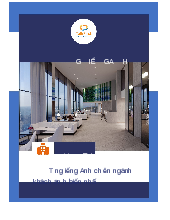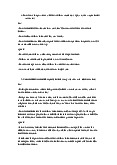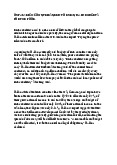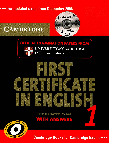



















Preview text:
LESSON 1 FORM COMPLETION
1. In the listening test, you are often asked to complete part of a form by writing
a number or a name which is spelled for you. Listen to eight speakers and decide
if each name or number is written correctly (ü) or incorrectly (û). (Track 1-CD1) 1 Romney 2 Cairns 3 Bragg 4 Jeckyll 5 Fawcett 6 15 cents 7 0726 05791 8 30 Lower Road
2. Work in pairs. Spell out these names and read these numbers to each other.
Then listen to check your answers. (Track 2) 1 Bracken 2 Gower 3 Jeremy 4 Pollard 5 Vernon 6 17 7 01950 674236 8 31st
3. Work in small groups. You are going to hear a man phoning to ask about a
holiday apartment. Before you listen, answer these questions. 1
What are the advantages and disadvantages of staying in an apartment when you're on holiday? 2
What sort of holiday accommodation do you prefer? 1
4. Work in pairs. Look at the form below.
1 In which gaps do you think you will have to: a write a number only?
b understand words which are spelled out?
c write a number and a word?
2 What sort of information do you need for the other gaps? Dubai Palm Apartments Enquiry taken by: Amanda Name: 1 __________ Address:
37 2 __________, Vienna Telephone number: 3 __________ Number of people: four Starting date: 4 __________ January Length of stay: 5 __________ Price per day: maximum 6 __________ Other requirements:
• fully equipped 7 __________
• view of 8 __________ • air conditioning must be __________
• 10 __________ for car
5. Now listen and complete the form. Write no more than TWO WORDS
AND/OR A NUMBER for each answer. (Track 3) Exam advice Form completion
• Before you listen, think what information you need for each gap.
• Do not write more words than the instructions tell you to.
• Write words or numbers you hear.
6. Work in pairs. Take turns to talk about a place you have stayed at. Say why
you stayed there, who you stayed with, and what you did while you were there. 2 LESSON 2 NOTE COMPLETION
1. Work in pairs. Match the questions (1-8) with the gapped answers (a-h). 1
Could you read the long number a ……12th to me, please? b Visa card no: …… 2 Could you give me a contact c occupation: ...... number, please? d …… Street 3 How much is the flight to e about……km Madrid? f at……p.m. 4 What date's your birthday? g price: $ 5 What time shall we meet? h mobile: …… 6 Can you tell me what you do? 7 How far is it to your office? 8
I wonder if you could tell me the address?
2. Which answers in Exercise 1 need: 1 words only? 2 numbers only? 3 words and numbers?
3. Listen to four conversations and complete four of the answers to the questions
in Exercise 1 (a-h). (Tracks 7-10)
4. Work in small groups. You are going to hear a conversation between a man
and a woman who are looking for someone to travel with them to some distant
mountains. Before you listen, write down five things you think someone who is
going on a difficult journey should know how to do.
Example: He/She should know how to cook.
5. Look at the notes below. For which question(s) will you have to: a write a number? b spell a word? c write the name of a place?
d write a subject of study or a language?
e write an activity which people do in their spare time? f write the name of a job? 3
Name: Sanjay 1 __________ Age: 2 __________
Occupation: 3 __________ Other expeditions:
• has crossed 4 __________
• has climed Mount 5 __________ Special skills:
• has done a 6 __________ course
• can speak 7 __________ Qualifications:
• degree in 8 __________ Free-time activities: • 9 __________
• keeping 10 __________
6. When you listen to the recording, you will often hear a phrase which signals
the answer to a question. Match each of these phrases (a-i) with one of the gaps
(1-10) in Exercise 5. You will need the same phrase for both gap 9 and gap 10. a a trip he made ... across b been to university
c like doing in his spare time
d he can hold conversations in e he's called f he's done a course in g how old he is h they went up a mountain i what does he do 4
7. Listen and complete the notes in Exercise 5. Write NO MORE THAN TWO
WORDS AND/OR A NUMBER for each answer. (Track 11) Exam advice Note completion
• Before you listen, decide what information you need and what type of word or
number you can write in each gap.
• Write words you hear and spell them correctly.
8. Match these phrases to make sentences. 1. I can operate a. the guitar.
2. I’d like to be able to play b. a car.
3. I want to learn how to cook c. a computer. 4. I know how to drive d. simple meals.
9. Work in pairs. Look at these two questions. Which sentences from Exercise 8
answer question 1, and which answer question 2? 1. What skills do you have?
2. What skills would you like to have? Why?
10. Work in pairs. Take turns to ask and answer the questions in Exercise 9. 5 LESSON 3
LABELLING A DIAGRAM, MULTIPLE CHOICE
1. Work in pairs. You are going to hear an information announcement for
passengers on a ship. Before you listen, look at the diagram above and answer these questions. 1 Where are you on the plan? 2 Which places are on A Deck?
3 Which places are next to reception?
4 What places are below reception?
5 Which questions may need the name of a place on the ship?
6 Which question may need the name of something you can eat or drink?
7 Which question may need the name of something you can take to your cabin?
2. Each of these extracts from the announcement is related to one of the gaps on
the diagram. Write the number of the gap by each extract.
a ... people who want a bit of fresh air ... 5
b On this deck, that is B Deck, you'll also find an area where you can either play games ...
c To access your cabin, ...
d … just next door .. . is a 40-seat cinema ...
e ... go up the stairs to A Deck, where you'll find the restaurant. Exam advice Labelling a diagram
• Look at the diagram and decide what type(s) of word you need.
• Look at the words on the diagram and listen for similar words and phrases to
tell you the answer is coming. 6
3. Now listen and label the diagram. Write ONE WORD ONLY for each answer. (Track 17)
4. Read Questions 6-10 and underline the key ideas in each question. Questions 6-10
6 At approximately what time will the ship arrive?
A at 7 a.m. B at 8 a.m. C at 9 a.m.
7 Which of these can children have in the restaurant?
A a children's menu B earlier mealtimes C a children's party
8 What are available at a reduced price?
A souvenirs of the ship B first-class cabins C train tickets
9 Which of these is situated in the lounge? A a computer B a coffee machine C a television
10 What special event will happen during the voyage? A a fashion show B a concert C a competition
5. Each of these phrases from the recording will help you to focus on the correct
question when you listen. Write the number of the question (6-10) by each phrase.
a. a unique feature on this crossing only 10 b. for those using the lounge c. for 20 percent off d. passengers with children e. reaching our destination
6. Now listen and answer Questions 6-10. Choose the correct letter: A, B, C. (Track 18) Exam advice Multiple choice
• Underline the key idea in each question to help you focus on the meaning.
• Listen for a phrase which means the same as one of the options. 7 LESSON 4
SENTENCE COMPLETION, PICK FROM A LIST.
1. Work in pairs. You are going to listen to a woman, Irina, talking to a man at
the ticket desk at an exhibition.
1. Have you ever been to an exhibition? If so, what did it show, and what did you like and dislike about it?
2. What sort of exhibitions might interest you? Why?
2. Look at Questions 1-6 below.
1. How many sections are mentioned?
2. Which sections relate to which sections?
3. Underline the key ideas in each sentence. Questions 1-6 Electronics exhibition
1. The first section deals with electronics designed to __________ the environment.
2. One new device is for checking __________ temperatures at different levels.
3. The theme of the second section is children and their __________ .
4. There are a number of inventions to avoid an __________ in the home.
5. They demonstrate a device for checking if older children are at __________ .
6. The third section contains devices for dealing with __________ .
3. Listen and complete Questions 1-6 in Exercise 2. Write ONE WORD for each answer. (Track 22) Exam advice Sentence completion
• Underline the key idea(s) in each sentence and think what information you
need to complete the sentences.
• Listen and write the words when you hear them.
4. Look at Questions 7-10 below. Underline the key ideas in each question. 8 Questions 7-10
7. Which TWO reasons does Irina give for visiting the exhibition? A. to meet a friend B. to improve her knowledge C. to buy something D. to check prices E. to entertain her child
8. Which TWO devices has Irina bought recently? A. a calculator B. a computer C. a camera D. a phone E. a digital recorder
9. What TWO things does Irina like about the building? A. the electric lights B. the space C. the activity D. the ceiling E. the entrance
10. Which TWO problems did Irina have coming to the exhibition? A. driving in heavy traffic B. finding the car park C. parking the car
D. waiting to enter the exhibition
E. standing outside in the rain
5. Now listen. Choose TWO letters A-E for each question (7-10) in Exercise 4. (Track 23) Exam advice Pick from a list
• Underline the key idea in each question
• Listen carefully: you may hear something about the wrong answers as well as
the correct answers, and the speakers may not use the same words as in the questions. 9 6. Work in pairs.
1. What electronic devices interest you? Why?
2. What electronic devices would you like to buy in the future? 10 LESSON 5
TABLE COMPLETION, LABELLING A MAP OR PLAN
1. You are going to hear an information officer at a zoo talking to a group of
visitors. Before you listen, work in pairs. 1. Do you think it is a good idea to keep animals in zoos? Why? / Why not? 2. What can children and adults learn from zoos?
2. Look at this table. What information do you need for each gap?
Animal World – today’s events name of event location type of event time The World of Ants the 1__________ 2 __________ 11 a.m. The 3 __________ 4 __________ film 12 noon Encouraging Exhibition Room demonstration 2.30 p.m. 5 __________ Birds of Prey the lawn 6 __________ 7 __________ p.m.
3. Now listen and complete the table above. Write NO MORE THAN TWO
WORDS OR A NUMBER for each answer. (Track 27) Exam advice Table completion
• Before you listen, read the table to see what information you are given and what information you need.
• You hear the answers in the same order as the questions in the table. 11
4. Work in pairs. You are going to hear the information officer saying where
things are in the zoo. Before you listen, look at the map below and answer these
questions. For some of the questions, you must answer with a letter, e.g. A. 1. Where are you on the plan?
2. If you take the left-hand path when you come to the lake, what is on your left?
3. If you take the right-hand path when you come to the lake, what is on your left?
4. What animals are next to the lake on your right?
5. What is between D and the penguines?
6. Which two places are opposite D?
7. What is over the crossroad on your right?
8. If you turn left at the crossroad and continue walking past B, what is on your left?
5. Now listen and write the correct letter (A-G), next to these questions (1-3). (Track 28) 1. gift shop 2. restaurant 3. picnic area Exam advice Labelling a map or plan
Before you listen, check where each of the options is in relation to where:
• you are on the map/plan
• the things are which are already labelled 12 LESSON 6 MATCHING. PICK FROM A LIST
1. Work in pairs. You are going to hear a conversation about successful people.
Before you listen, look at the photos below and discuss these questions.
1. What do you think has made each person successful?
2. Complete this sentence: The key to success is …
2. Read Questions 1-4 and options A-F. How many extra options are there? What
words/ideas do you expect to hear for each option? Questions 1-4
What helped each person to become successful?
Choose FOUR answers from the box and write the correct letter, A-F, next to Questions 1-4. People 1. the film maker 2. the ballet dancer 3. the scientist 4. the chef Reasons for success A. a personal style B. a lot of money
C. a relative’s influence D. an invention E. a wise decision F. a change of job
3. Now listen and answer Questions 1-4. (Track 5-CD2) 13
4. Listen to the recording again and when you hear the speakers’ questions
below, note down a few words that give you the answer. Use these to check your
answers to Questions 1-4. (Track 5-CD2)
1 So what made him successful? uncle/ film student
2 Was she very talented?
3 So why did she do better?
4 Did he make a famous dish? Exam advice Matching
• Read the questions and options and think about what they mean.
• You hear the answers in the same order as the questions.
5. Look at Questions 5-10 below and underline the key ideas in each question.
Quickly read through the options. Questions 5-10
Choose TWO letters, A-E. Questions 5-6
Which TWO criteria will the students use to choose a successful person? A. age B. gender C. individual talent D. fame E. global importance Questions 7-8
Which TWO things do the students agree to do before they meet again? A. write a biography
B. conduct more research C. find photographs D. write a talk E. plan a seminar Questions 9-10
Which TWO things do the students agree are linked to success? A. wealth B. experience C. talent D. effort E. location 14
6. Now listen and answer Questions 5-10. (Track 6-CD2) Exam advice Pick from a list
• Underline the key ideas in each question.
• Quickly read through the options before you listen.
• Remember to choose two answers for each question.
7. Work in pairs. Look again at the options in Questions 5-6 and 9-10. Which
three of these do you think are most important for success? 15 LESSON 7
FORM COMPLETION, MULTIPLE CHOICE
1. Work in small groups. You are going to hear a student talking to someone on
the telephone about doing an online course. Before you listen, discuss these questions.
1. Have you ever done an online course?
2. Are online courses popular in your culture?
2. Work in pairs. Look at Questions 1-5 below.
1. What type of information do you need for each gap? (e.g. a date, a place)?
2. What will you write in each gap (letters, words, numbers or a combination of these)? Questions 1-5
Complete the form below. Write NO MORE THAN TWO WORDS AND/OR A NUMBER for each answer.
3. Now listen to the first part of the conversation and answer Questions 1-5. (Track 7-CD2) Exam advice Form completion
• Use the words already on the form to help you listen for the answers you need.
• Check your spelling is correct. 16
4. Work in pairs. Read Questions 6-10 quickly. Underline the key ideas in each question. Questions 6-10
Choose the correct letter, A, B, or C.
6. The caller wants to do a writing course to help with A. his hobby B. his job C. his children’s education
7. What does the course pack include? A. multimedia items B. a list of books to buy
C. lesson and assignment dates
8. How much does a course cost? A. £340 B. £375 C. £400
9. Alex’s first assignment will be about his A. family life B. school experiences C. expectations of the course
10. What does the feedback include? A. a tutorial B. an exercise C. a discussion group
5. Now listen and answer Questions 6-10. (Track 8-CD2) Exam advice Multiple choice
• Underline the key idea(s) in each question.
• Listen for the same words or words that have the same meaning. This will tell
you that the answer is coming.
• Match what you hear to the correct option – you may hear the same words or a paraphrase of the answer.
6. Now look at the recording script. Listen again and underline the words in the
script which gave you the answers. (Tracks 7-8-CD2)
7. Work in pairs. Ask and answer these questions.
1. What do you write in your own language?
2. How easy do you find it to write in English? 17 LESSON 8
SENTENCE COMPLETION, TABLE COMPLETION
1. You are going to hear a tour guide welcoming visitors to a science museum.
Before you listen, work in small groups. Here are some of the things you can see
at the museum. Which three would you most like to see? Why?
2. Work in pairs. Read Questions 1-5 and decide what type of information you need for each gap. Questions 1-5
Complete the sentences below. Write NO MORE THAN TWO WORDS AND/OR A NUMBER for each answer.
1. Keep your _________ in a safe place throughout your visit.
2. Pass through the _________ to enter and leave the museum.
3. You need to buy a _________ if you want to use a camera in the museum.
4. Look after your _________ and mobile phone.
5. Arrive at the cinema about _________ before the start of the show.
3. Now listen and answer Questions 1-5. (Track 13-CD2) 18
4. Work in pairs. Look at the key words and phrases below from Questions 1-5.
Listen to the recording again and note down the words the speaker uses that
have a similar meaning. (Track 13-CD2) 1. keep 6. use a camera 2. safe 7. look after 3. enter 8. arrive at 4. leave 9. before the start 5. buy Exam advice Sentence completion
• Use words in the sentence to help you listen for the answer.
• Check the completed sentences are grammatically correct.
5. Work in pairs. Look at the table below and decide what type of information you need for each gap. Questions 6-10 Complete the table below.
Write NO MORE THAN TWO WORDS AND/OR A NUMBER for each answer. 3D Film Choice name of film time what you will see The Secrets of the 10.00 a.m.
The first 6 __________ along the river Nile Nile
7 __________ Ocean 11.45 a.m. Life at the bottom of the sea Dinosaurs Alive 8 __________
A re-creation of a 9 __________ of dinosaur Arabia 2.30 p.m.
A trip across the 10 __________ and a dive in the Red Sea.
6. Now listen and answer Questions 6-10. (Track 14-CD2) Exam advice Table completion
• Use the title and headings in the table to focus your listening.
• Check tour writing to make sure you have not written unnecessary or incorrect words. 7. Work in pairs.
1. Do you have any museums in your hometown? What can you see and do there?
2. What types of museum do you most enjoy visiting? Why? 19 LESSON 9
MATCHING, FLOW-CHART COMPLETION
1. Work in pairs. You are going to hear a student talking to a tutor about a talk
he is preparing on ‘desalination’ – the process of making fresh water from seawater.
1. Why do you think desalination is important?
2. Have you ever given a talk to a group of people? What was it about?
3. How did you prepare for it?
4. How did you feel about it before and afterwards?
2. Read the task below. Underline the key ideas in the opening question and the box of options (A-C). Questions 1-5
What comment does the tutor make about each part of the presentation?
Write the correct letter, A-C, next to Questions 1-5
NB You may use any letter more than once. Parts of Presentation 1. the introduction 2. the background
3. the description of the process
4. the advantages/disadvantages 5. the conclusion Comments A. It needs to be shorter
B. The ideas are difficult to follow
C. Some information should be added
3. Now listen to the first part of the conversation and answer Questions 1-5. (Track 21-CD2) Exam advice Matching
• You may have to use the same option more than once.
• Use the key ideas in each question to help you listen for the answers. 20




